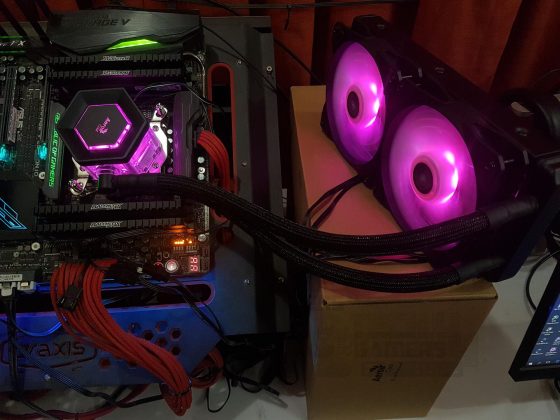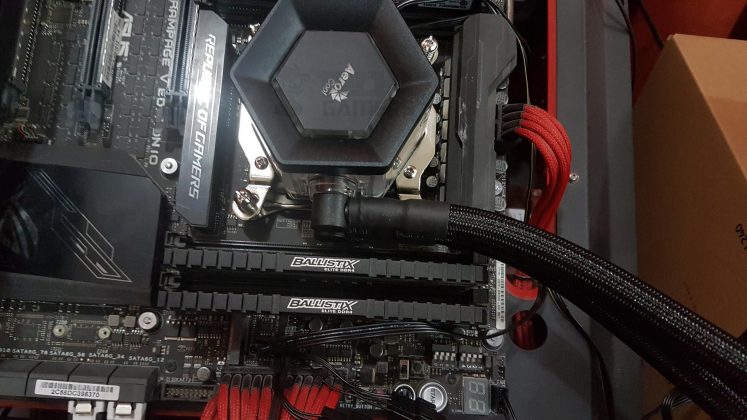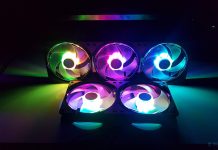Silent Aesthetics, Strong Performance
Review Summary
The Aerocool P7 L240 is a 240mm closed-loop liquid cooler that strikes a balance between performance, low noise, and RGB aesthetics. Its transparent pump chassis and P7-F12 translucent fans offer 16.8 million colors customization, delivering visually stunning looks. The cooler impresses with easy installation, silent operation, and decent cooling, but potential drawbacks include a higher price point, the need for additional purchases like the P7-H1 RGB Controller hub, and possible RAM clearance issues. Despite these considerations, it’s a compelling choice for enthusiasts seeking a premium cooling solution with vibrant RGB lighting.
Hours Tested: 5
Overall
-
Build Quality - 8/10
8/10
-
Design - 7/10
7/10
-
Performance - 9/10
9/10
-
Features - 7/10
7/10
-
Value - 7/10
7/10
Pros
- Silent Operation
- Easy Installation
- RGB Aesthetics
- Decent Cooling
Cons
- Higher Price Point
- No Included RGB controller
Aerocool has sent their Project 7 series for Aerocool P7 L240. Project 7 is Aerocool’s branding for their RGB Gaming line up of enthusiast-level products ranging from PSU to Fan to the Chassis. Today, I will be taking a look at their P7-L240.
The Aerocool P7 L240 is a 240mm closed-loop liquid cooler featuring a transparent pump chassis and P7-F12 translucent fans. With RGB compatibility, users can enjoy customization with 16.8 million colors for visually stunning aesthetics. This design is unique to Aerocool.
Key Takeaways
- The Aerocool P7 L240 is for those looking for an easy-to-install 240mm AIO liquid cooler that also remains silent.
- The Aerocool P7 L240 is not for anyone looking for a cheap 240mm cooler.
- The Aerocool P7 L240 provides a silent experience, decent cooling, as well as RGB lighting.
- Why you can trust Tech4Gamers: Our reviews are based on dedicated hands-on testing by our team of experienced hardware experts. Find out more about how we test.
Let’s start with the specifications.
| Product | P7-L240 |
| Intel Socket | Intel LGA 2066, 2011-V3, 115X, 1366, 775, 1200 |
| AMD Socket | AMD FM2, FM1, AM4, AM3+, AM3, AM2+, AM2 |
| Pump | 2500 RPM |
| Power Consumption | 8.4 Watts |
| Fan | 2 x 120mm |
| Fan Speed | 600-1800 RPM |
| Fan Bearing | Hydraulic Bearing |
| Noise Level | 10.5 – 31.8 dBA |
| Current | 0.16 A (One Fan) |
| Airflow | 29.84 – 71.65 CFM |
| Static Pressure | 0.59 – 1.34 mm-H2O |
| Connector | PWM 4-Pin |
| Radiator | 280mm x 120mm x 53mm |
Packaging and Unboxing
Here is the complete unboxing experience.
Accessories and Content
The user manual is well-designed and in a booklet format. It has pictures to help the user in the installation of the cooler.
Closer Look
The Aerocool P7 L240 Review is a 240mm CLC cooling solution. It has a 240mm radiator with two P7-F12 RGB, and 120mm fans.
Radiator
The radiator dimensions are 274.8 x 120.5 x 27mm with a 27mm thickness. With 25mm fans, the overall thickness is 52mm. It features low-density fins per inch, allowing efficient air passage with minimal resistance.
This radiator accommodates airflow-capable fans without compromising performance, ensuring low-noise operation. Crafted from lightweight aluminum, it reflects Aerocool’s unique design, featuring blocks with rounded edges on both ends.
The radiator’s low-density fin stack, along with left and right side channels, creates a total of 12 water flow channels. It incorporates standard inlet and outlet blocks for efficient hot water flow, entering from the inlet and passing through the designated channels.
Heat is blown away through the fins by the fans and cold or normal temperature water flows out of the radiator through the outlet port. Here are some of the radiator’s specs that I have gathered:
| Dimension | 274.8 x 120.5 x 27mm (L x W x D) |
| Material | Aluminum |
| Channels | 12 |
| FPI | 18 [As per our sample] |
| Liquid Capacity | 250ml |
| OD/ID | 9.525mm/8.3mm |
| Cooling Capacity | 380W |
When mounting fans, avoid longer screws to prevent damage to the fins beneath the fan mounts. I recommend using the provided long screws for optimal performance. The hoses are securely attached to both the radiator assembly and pump housing.

The soft material tubing is flexible and doesn’t produce kinking which is always a plus. Aerocool used heat shrinks on the terminating ends of the hoses on the radiators. Aerocool is using mesh sleeves on the hoses to give them a clean look.
Pump
Let’s take a look at the main element of this Aerocool P7 L240 Review cooler. The majority of the CLCs in the market have pump housing on the water block without any reservoir on top of it. This design trades off the capacity in exchange for occupying less space. Raijintek introduced the design in which there was an integrated reservoir and pump combo on the water block.
The transparent housing on the reservoir provides an additional advantage in terms of the cooler’s overall aesthetics. Following a similar design approach, Reeven introduced the Naia 240 with the same concept. They also implemented the white LED lighting inside the housing which I wish would have been an RGB LED instead. Aerocool is using the same concept with their L240 but with perfection.
The pump features an integrated reservoir in stylish hexagonal transparent housing, enhancing aesthetics and increasing liquid capacity. The block dimensions are 95mm x 80.5mm x 61.6mm (L x W x H), larger than many other CLCs available.
There is a black color hexagonal top on the reservoir/pump combo. It has an Aerocool brand name and logo printed on it which illuminates when the unit is powered on. It is placed on top of the unit’s top cover housing which is also in black color and it is removable as well.

This cover is also in hexagonal shape to go in symmetry with the overall design of the unit. We have a large transparent housing of the unit with RGB LED lighting solution in it which really gives stunning looks.
The hexagonal-shaped pump has a visible pump top and a fill port under the top plate. To access the fill port, rotate and lift off the cap. The top plate, connected to the top cover, is removable, and an extra top plate is included.
The fill port allows coolant addition for prolonged cooler life. Use the provided dropper for coolant. Note that screwing the cap back on may cause additional spills.
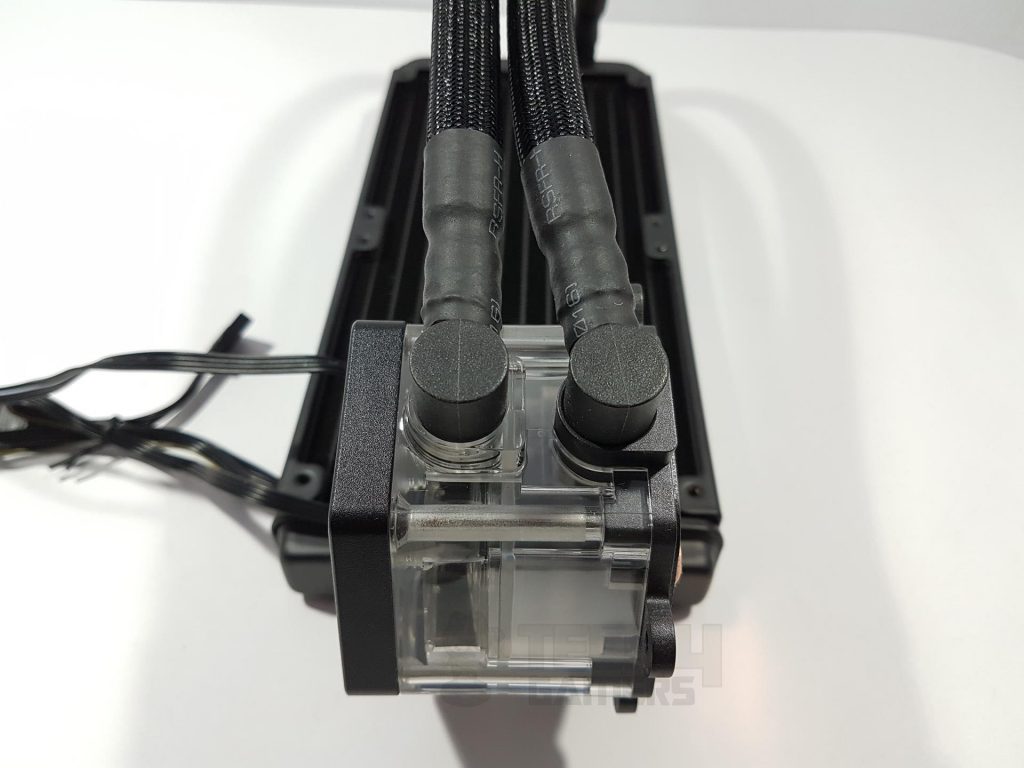
The pump housing has hoses at a 90° angle, protruding noticeably, potentially causing RAM clearance issues. While the hoses can be rotated upward and downward, there’s limited movement due to their orientation. The bottom side features black plastic with 4 mounting holes, one on the side of the hexagonal shape.
Two cables emerge from the pump housing: a 4-pin power cable and a dual-headed RGB LED cable. The RGB cable can connect to the motherboard’s RGB header or the separately sold P7-H1 RGB Controller hub.
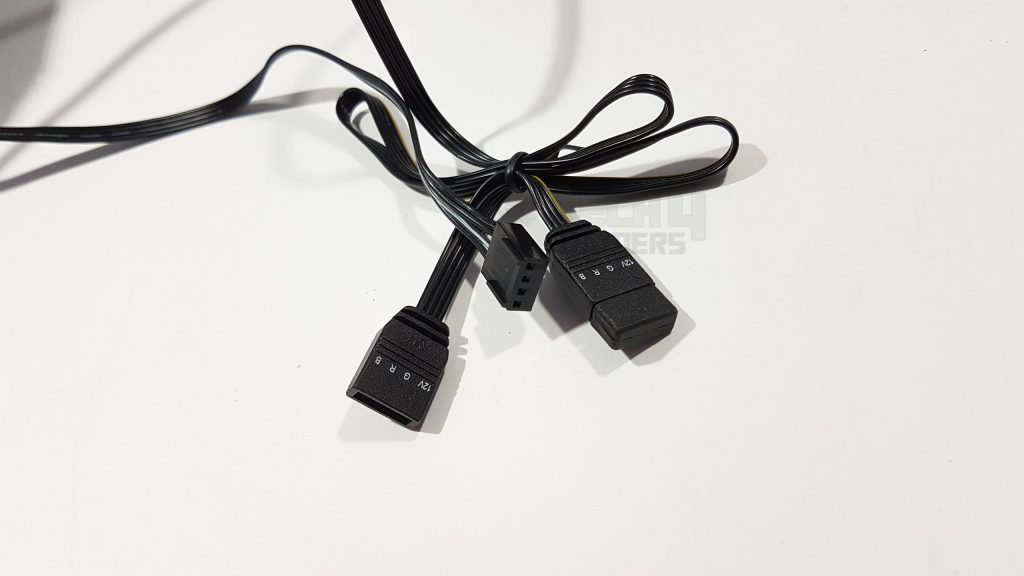
The unit supports daisy-chaining with fans through a single RGB control cable and features a dual soundproof chamber design to minimize noise while adding extra fluid capacity. Its motor is equipped with a balanced impeller and high-quality ceramic bearing, ensuring near-silent performance.
The pump specifications include a rated speed of 2500 RPM at 12V, a flow rate of 800 LPH, a power consumption of 8.4 Watts, a noise level of less than 25 dBA, and an MTBF of 80,000 hours. The 4-pin power cable has a length of approximately 465mm, while the RGB LED cable measures 471mm + 54mm.

The block’s base is a rounded hexagonal shape with a raised surface in the middle housing the pure copper cold plate. It follows a microchannel design with 131 channels and 132 fins, each 0.1mm wide and spaced 0.11mm apart. This configuration aims to optimize heat dissipation for improved thermal performance.
The cover of the unit can be positioned in two different orientations to make installation more convenient as per the user’s requirements. However, this Aerocool P7 L240 Review design is not compatible with the socket layout of some motherboards. These motherboards are mentioned in the below picture.
This is due to the hoses implementation in the pump housing at 90°. As the hoses are more protruding and are at 90° offset the first DIMM slot closer to the CPU socket is covered with the hoses raising the RAM clearance issue.

Fan
Aerocool has provided two P7-F12 fans with the cooler. These are their Project 7 series 120mm RGB-enabled fans. I am not sure if these are addressable RGB versions as the software does not have any rainbow mode in the option. But still, these can have color customization from 16.8 Million colors. We have a circular frame with triangular edges around them.
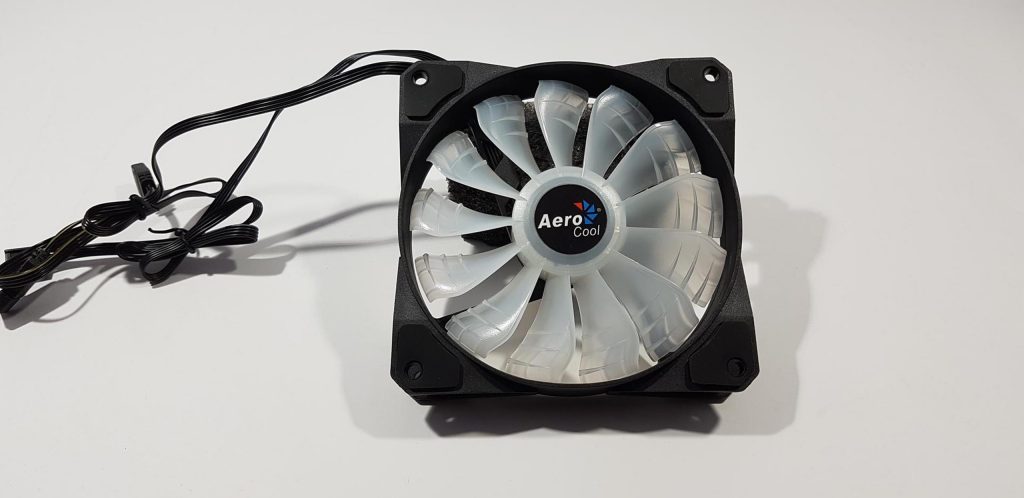
There are anti-vibration pads in black color on each mounting corner. There is a distance of approximately 110mm between any two mounting holes on the same side. Each fan has 13 blades. This design is usually found in airflow edition fans, not high static pressure series fans. Blades are translucent. There is a sticker pasted on the motor hub with the Aerocool brand name and logo printed on it.
The fan blades feature raised tabs on the exterior, enhancing air direction and reducing noise. The illuminated design, powered by 6 RGB LEDs in the translucent hub, creates a visually stunning effect. The backside reveals a 4-arm assembly connecting the hub to the frame, with Aerocool branding on the motor hub sticker indicating model AV 12025 and 12V DC 0.15A.

The P7-F12 fan has a 120mm x 120mm x 25mm dimension, operates at 600-1800 RPM, and features a 4-pin PWM connector. It includes an RGB LED with dual connectors for lighting and daisy-chaining. The hydraulic bearing ensures a 60,000-hour lifespan.
Rated at 12V, it has a start voltage of 9V, consumes 0.16A (1.92W), and offers airflow of 29.84-71.65 CFM with a noise level of 10.5-31.8 dBA. The 4-pin power cable is 440mm long, and the RGB LED cable is 471 mm+54 mm. The impeller is removable for easy cleaning.
Software and RGB Lighting
To control RGB lighting on fans and the pump unit, you can use the Aerocool P7-H1 RGB Controller hub (sold separately) or a motherboard with compatible RGB headers such as Asus Aura Sync, Gigabyte RGB Fusion, or MSI Mystic Lighting. The Aerocool P7-H1 hub includes the S1 software, offering a user-friendly interface for customizing lighting effects with 16.8 million colors.
Here’s the pump lighting in action.
Installation
We have tested the cooler on the X99 platform using 2011-3 socket.
The installation mechanism is pretty much straightforward on this socket as you don’t need a mounting bracket/backplate on this socket.
- Take out the mounting bars from the transparent container with the label C (2011).
- Place each mounting bar on each side of the pump housing by aligning the mounting holes on the housing with the holes on the mounting bar.
- Each mounting bar has spring-loaded screws on each end. Make sure that the spring side of the mounting bar is facing up.
- Use the four silver color screws and secure the bars with the pump housing. Apply the thermal paste on the IHS of the CPU.
- Remove the warning label from the base of the unit and put the unit on top of the CPU IHS by aligning the socket holes with the spring-loaded screws.
- Once aligned, start screwing them in. Use a diagonal pattern to apply even the pressure of the block.
- Connect the 4-pin connector to the required header of the motherboard. In our case, we connected it to the 4-pin pump header on our Asus motherboard.
- We daisy-chained the fans and the pump RGB LED connectors and used P7-H1 as well as the onboard Aura header to test the lighting solution.
We have already discussed the DIMM clearance issue with this cooler. As can be seen in the pictures, this design approach makes it difficult to use the DIMM slot closer to the CPU Socket.
Testing Methodology
Following test bench was used for testing this Aerocool P7 L240 Review cooler: –
- Asus Rampage V Edition 10
- Intel i7 6850k
- Crucial Ballixtics Elite 4x4GB @ 3000MHz
- Nvidia GTX 1080 FE
- Samsung 840 EVO 250GB SSD
- WD Black 6TB
- Corsair AX1200i
Following software were used for the testing and monitoring.
- Asus Real Bench v 2.44
- Real Temp GT v 3.70
The Noctua NT-H1 thermal paste is consistently used for all coolers to ensure standardization in testing. Testing involves stressing the cooler with Asus RealBench 2.44 at 3.6GHz stock clocks and 4.3GHz overclocked setting with 1.350V manual Vcore. The stress test runs for 60 minutes followed by a 15-minute break. Fans and water pumps are set to 100% RPM.
The reported data includes the max average temperature from three tests, calculated by summing up max temps on each core and dividing by the core count. Delta temp is determined by subtracting ambient temp from the max average temp. No rounding is applied to ambient temps.
Aerocool P7 Results
Let’s take a look at the graphs. On stock clocks, the CPU was idling at 2.5°C. 27.13°C was the temperature under stress testing. The cooler is sitting nicely between the Corsair H100i V2 and the Noctua NH-D15 with Corsair H100i V2 leading by 0.8°C and NH-D15 trailing behind by 0.1°C. These three coolers were approximately giving the same performance within 1°C delta.
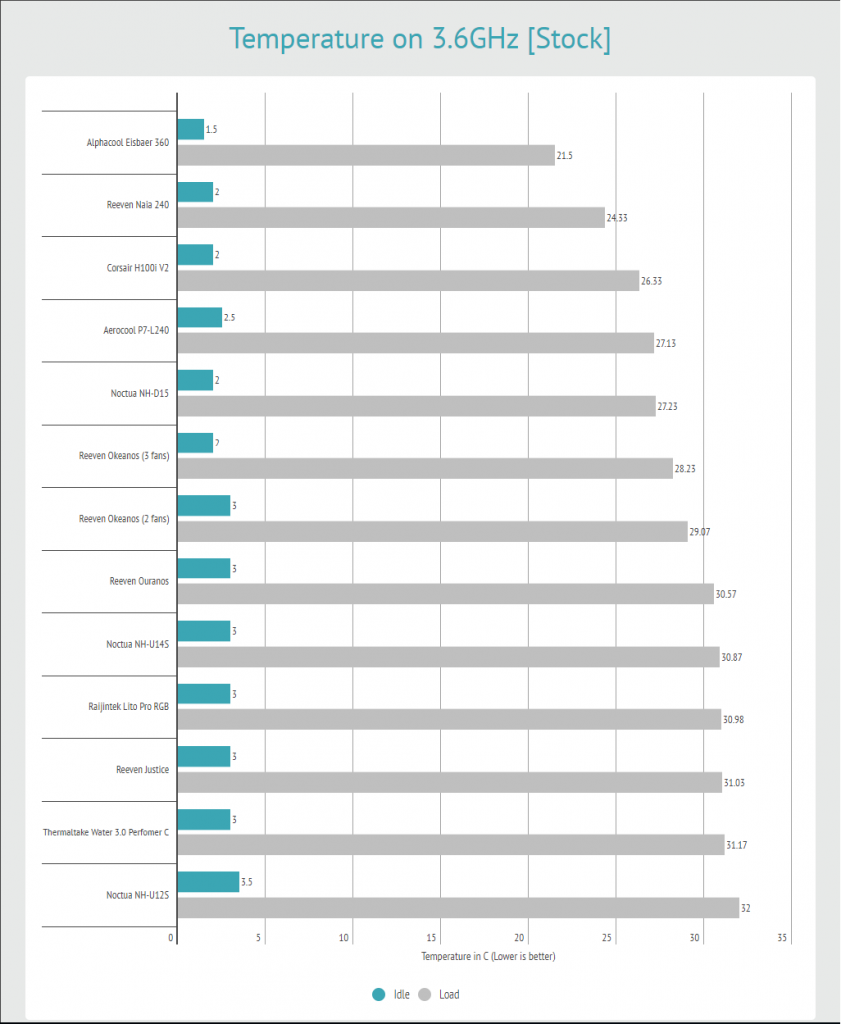
With overclocked 6850k to 4.3GHz at 1.350V, the CPU was idling at 4°C. 41.83°C was the temperature under the stress test. Corsair H100i V2 was leading by 0.67°C whereas the Noctua NH-D15 was leading by 0.83°C. Reeven Okeanos with triple fans was leading by 0.76°C. Again, these three coolers were approximately giving the same performance within 1°C delta.

Our Fonseo Digital Sound Meter was showing 34 dBA under full load with 11 dBA when idling.

Should You Buy It?
Is the Aerocool P7-L240 worth purchasing?
Buy It If:
✅You prefer a silent experience: The Aerocool P7-L240 remained silent for the most part during my tests.
✅You want an easy-to-install 240mm cooler: The Aerocool P7-L240 CPU cooler has a very simple installation procedure.
Don’t Buy It If:
❌You want to benefit from an RGB controller: Unfortunately, the cooler does not come with an RGB controller.
❌You are on a budget: While the Aerocool P7-L240 is a fairly priced cooler, it might not be for those working with a smaller budget.
Conclusion
The Aerocool P7 L240, a 240mm CLC cooler with two P7-F12 RGB fans, promises a vibrant 16.8 Million RGB experience. However, the absence of a rainbow mode raises doubts about addressable RGB compatibility. If you were to buy P7-H1 in addition to this cooler then the total bill would have been approximately $160 which is definitely on the higher side.
Priced alongside competitors like Corsair H100i V2 and Noctua NH-D15, the P7 L240 justifies its cost with robust cooling, moderate noise levels, and refill capability, as reflected in benchmarks. I was met with a few drawbacks during my review including potential RAM clearance issues, cable clutter, and the absence of an included RGB Controller Hub.
In my view, the P7 L240 impresses with its performance and RGB aesthetics, especially the pulsating lighting effect. However, the cable mess and additional purchases might be a turn-off. Enthusiasts seeking top-notch cooling with RGB customization may find value, but be cautious about the added costs and potential inconveniences.
We are thankful to Aerocool for giving us the opportunity to review their P7-L240 CPU Cooler.
Recent Updates
- January 16, 2023: Few text changes to improve readability.
Thank you! Please share your positive feedback. 🔋
How could we improve this post? Please Help us. 😔
[Hardware Reviewer & Editor]
Meet Nauman Siddique, a highly experienced computer science graduate with more than 15 years of knowledge in technology. Nauman is an expert in the field known for his deep understanding of computer hardware.
As a tech tester, insightful reviewer, and skilled hardware editor, Nauman carefully breaks down important parts like motherboards, graphics cards, processors, PC cases, CPU coolers, and more.
- 15+ years of PC Building Experience
- 10+ years of first-hand knowledge of technology
- 7+ years of doing in-depth testing of PC Hardware
- A motivated individual with a keen interest in tech testing from multiple angles.
- I majored in Computer Science with a Masters in Marketing
- Previously worked at eXputer, EnosTech, and Appuals.
- Completed Course in Computer Systems Specialization From Illinois Tech


 Threads
Threads




































